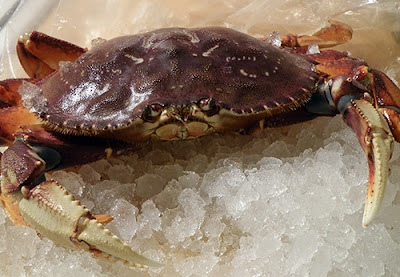 |
| Object of our (Culinary) Affection |
Recipe by Robin
As promised in last
year’s post about selecting and reheating precooked Dungeness crab, today
we’ll tackle cooking a live crab. Dungeness, a west coast (US) winter delicacy,
is low in calories and high in protein. It’s also sustainably
fished. Crab traps sit on the bottom of the ocean with very little impact
on the local environment. Only mature crabs of legal size can enter the trap,
and traps are designed to allow very little bycatch of other species. Of
course, if you’ve ever observed crabs in an amateur’s aquarium, you’ll notice
that given some time they eat every other species that comes near them, even
fish and snails. They respond quickly to changes in their environment,
typically with their claws. This fast response time and unrelenting claw action
are the two main factors to heed when handling live crabs of any variety.
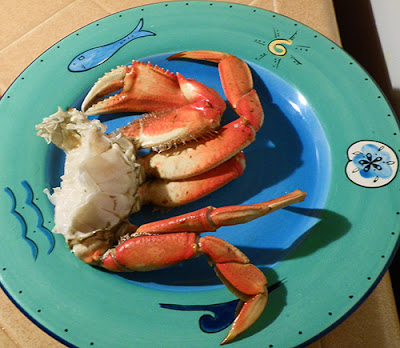 |
| Our Motivation for Cleaning Crab |
After the crab is out of the pot and carapace is removed,
there are more guts. First you’ll see the green stuff, the crab’s
hepato-pancreas, smooshed all over. In female crabs, you might also see red
eggs (coral). These are both technically edible, and some hearty folks gather
this stuff to make crab
butter, which is reputedly delicious. Frankly, I’m a bit squeamish, so I
rinse the leg portion off with the sink sprayer and discard the carapace as is
with any residual guts. Finally, there are the gills, the truly inedible part
of the crab. These are sacs on either side of the body. Pinch them off and
dispose of them.
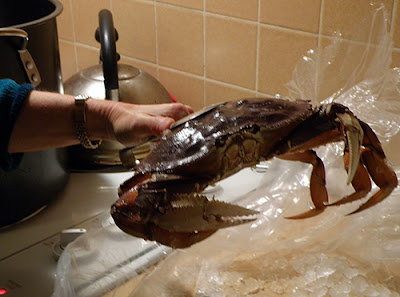 |
| Highly Recommended: Use Short, Wide Tongs |
Buying precooked,
cleaned crabs saves some time and effort, but if you have a source for
fresh crab and 30 minutes or less, you’re on your way to enjoying the freshest,
most exquisite crab on the planet. With a little planning and practice, you’ll
be preparing these crustaceans like a pro.
Before buying your crab, assemble everything you’ll need at
home. Put some water in a large pot with a steamer basket in the bottom. A
veggie steamer works fine, just unscrew and remove the center pole. Find the
tongs and clear the sink, which you’ll need for cleaning.
Solicit a store where they let you pick your crab, if
possible. Pick a lively looking crab, one who is moving its mandibles (mouthparts,) or
watching/responding to you as you approach the tank. I like the larger, more
aggressive males that tend to be on top of any pile-up. Allow ½ (1½ - 2 lb.) crab per person, unless
you have some hearty eaters or want to have leftover crab for crabcakes, etc.
Have the grocer put your crab on ice. For some reason they
don’t last as long packed in sea water, the way some fish markets prefer. Also,
the cold immobilizes them somewhat, so you’ll have an easier time handling the
crab. Give the crab about 30 minutes (or more) on ice. The crab should be
completely surrounded by ice.
Keep the crab on ice while bringing the water in the
steaming pot to boiling.
Pick up the crab from the back. I use short, controllable
tongs, since the crab is surprisingly heavy. Some brave souls use their bare
hands. Crabs can reach quite far under their bodies, so keep fingers well to
the back of the crab if you lift them this way. Often fishmongers lift them by
their two back legs, but it is possible for amateurs to break the legs off and
have the crab careen to an inconvenient spot with this method. Once they grab something
with their claws, they are reluctant to let go.
Try to tilt, shake, or brush off as much of the ice as
possible, minding the claws.
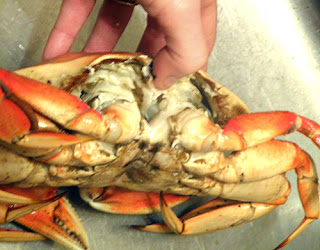 |
| Second Cleaning Step: Remove Carapace |
Steam for 7 – 8 minutes per pound. If you’re steaming more
than one crab, calculate your timing based upon average weight, and calculate
at 8 minutes per pound. This amounts to about 12 – 16 minutes steaming time for
average (1½ - 2 lb.) crabs.
Remove crab from pot, and place in colander. Bring to sink
immediately for cleaning.
Rinse the crab immediately to cool it down. A sink sprayer
is best. This stops the cooking process as well as cooling the crab enough to
handle. Some people dunk the crab in ice water, and this works fine if you like
eating chilled crab. If you like it hot, use the cool water spray instead.
Remove the apron (the flap on the belly) by grasping the
front and pulling it towards the back. This will leave a hole in the back where
you can grab the carapace (body shell). Put your thumb in this hole and gently
but firmly, pull up and towards the front, dislodging the carapace.
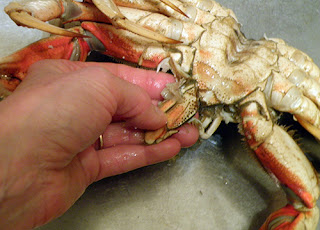 |
| Final Cleaning Step: Removing the Mandibles |
Pinch off gills, which are spongy projections on both sides
of the body. Lastly, remove the mandibles, the projecting mouthparts on the
underside of the body.
Break each crab in half and put on individual plates, or
pile up on a platter. Call the family or guests to the table and enjoy!
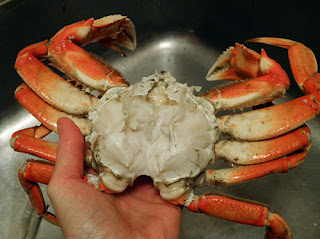

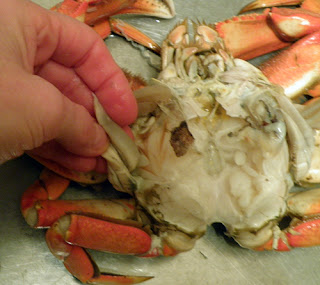
I wonder how much these cost here in New England. I would love to try them!
ReplyDeleteJodi, I'm also curious whether Dungeness is available in New England. Prices are running $6.95 - $9.95/lb. here so far this year. Last year they were a couple bucks cheaper, because of a larger harvest.
DeletePop the crab into the pot, bearing in mind that if not completely immobilized, the crab might try to grab the top of the pot. Endeavor to keep the claws clear of the pot.
ReplyDeleteHow can any human with any heart, throw a live animal into
a pot of boiling water?
Interesting ethical question. Here's another: is it any more humane to buy the crab pre-cooked? Let someone else pop it into the pot and not think about it? Perhaps a better question to ask ourselves is "Do I choose to eat crab at all, acknowledging how it is prepared?" Every individual must decide this for him/herself.
DeleteYes, and what about all the Wheat in the field screaming, "It's coming, it's coming, the harvestor is coming!"
ReplyDeleteInteresting, I've never heard anyone use wheat as the example of veggie-cide before. Usually it's carrots! :)
Delete